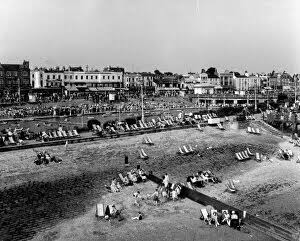Southend-on-Sea, located in Essex just east of London, is a town that holds both charm and a certain darkness. Once a popular seaside destination for Londoners seeking an escape from the city, the town has a history that stretches far beyond the amusements and arcades of its waterfront. Beneath its tourist-friendly surface lies a tale of transformation, with elements of the past still casting long, unsettling shadows over its modern identity. Southend may be known for its Victorian pier and traditional seaside attractions, but the stories buried within its streets tell of an unsettling past.
In the 19th century, Southend was a thriving fishing village. It was later transformed into a bustling holiday resort, with people flocking from London to enjoy its beaches and pier. However, in its early days as a resort, the town was riddled with issues like overcrowding and poverty. The once vibrant local economy, largely based on the sea, faced gradual decline. The shifts brought about by the industrial revolution and increasing tourism had unforeseen consequences. Southend’s growth was marked by a darker side—rampant exploitation and sometimes squalid living conditions.
As tourism took over in the early 20th century, Southend became a haven for thrill-seekers. The Southend Pier, the longest in the world, remained a symbol of hope and fun. Yet, as the town became synonymous with carefree escapism, there were accounts of strange disappearances and rumors surrounding the piers and beaches. Locals whisper about a handful of mysterious drownings in the cold waters, some of which still remain unsolved. The beach itself, once a paradise, was rumored to harbor dangerous undercurrents that claimed the lives of many over the years, leaving behind only haunting whispers and forgotten histories.
The darker aspects of Southend’s history go even deeper. In the 20th century, parts of the town became notorious for being the home of some of the UK’s most notorious criminals. One figure that became infamous in Southend’s history was the so-called “Southend Strangler,” a serial killer who eluded authorities for years. In the mid-1900s, this predator’s reign of terror left the town in a state of constant fear. While the killer was never officially apprehended, the chilling atmosphere that surrounded his crimes left Southend with a lingering sense of dread.
Today, Southend might be considered a vibrant town, but it is a place where the weight of the past is never far from the surface. In recent years, the rapid development of the town has masked some of the lingering issues beneath. Gentrification, though bringing in wealthier residents, has displaced many long-standing locals, contributing to social division. A deep-seated resentment remains between the new, affluent residents and the working-class individuals who have lived in Southend for generations. The tensions between old and new are palpable, and some believe the town’s rapid modernization is a form of gentrification that disregards the history and suffering of its people.
Then there’s the ongoing battle between the rich and the poor, which has created an undercurrent of strife. Southend’s high street, once bustling with independent businesses, has slowly succumbed to corporate retail chains. This has exacerbated the economic gap between those who thrive on the tourist trade and those who are left struggling to make ends meet. Despite the cheerful face of the seaside resort, a growing number of people are being pushed into poverty, with an increasing homeless population visible along the streets and piers.
Even more disconcerting are the strange occurrences that have continued in Southend’s more neglected corners. Residents have reported seeing eerie figures on quiet beaches at night, and some claim to have encountered unexplainable sights at the town’s abandoned landmarks. Southend’s shadowy past has left an imprint on its modern-day community, with many residents claiming to experience feelings of unease or a sense of being watched. Some swear by the old folklore and eerie myths that persist about the town, insisting that Southend is still haunted by the ghosts of its past.
In the end, Southend-on-Sea is a place of dualities. It is both a destination of joy and a town burdened with an unsettling history. From its rise as a working-class seaside retreat to its darker associations with crime and mystery, Southend has evolved into something more than just a town by the sea. It is a town filled with tales of shadowy figures, unsolved crimes, and strange occurrences that refuse to be forgotten. The question remains—can the town escape its haunting past, or will Southend forever be shaped by the ghostly remnants of its darker days?
